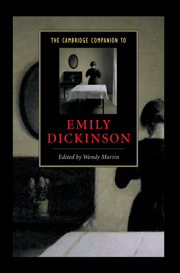11 - Emily Dickinson and her American women poet peers
from Part 3 - Cultural contexts
Published online by Cambridge University Press: 28 May 2006
Summary
While a host of feminist scholars, beginning in the 1970s, are principally responsible for Emily Dickinson's remarkable surge to the front ranks of major American authors, these same scholars have, for the most part, shown little interest in recuperating the poetry of other American women writers of Dickinson's day. Instead, by largely ignoring this sizable body of writing, they have helped maintain the cordon sanitaire that has, since the early decades of the twentieth century, cut the Amherst poet off from her peers. With only two exceptions - Cheryl Walker and Joanne Dobson - those Dickinson scholars who have touched on this subject, myself included, have done so largely at these other women poets' expense, setting them up not as authors in their own right but as so much prima facie evidence for Dickinson's genius and her ability to transcend the limits of her time, place, and gender. Thus, for example, the introduction to my 1990 study of Dickinson concludes, “At a period when, it seems, virtually every woman poet in the United States failed to rise above the limitations imposed on women's poetry by women's complicity in a system that oppressed them, Emily Dickinson sought 'taller feet.'” This assertion, at which I shudder now, implicitly treats the discussion of Dickinson qua nineteenth-century American woman poet as a zero sum game. The less her women poet peers could be said to have achieved, the greater Dickinson's own accomplishment became. Conversely, anything one gave to them, took from her.
- Type
- Chapter
- Information
- The Cambridge Companion to Emily Dickinson , pp. 215 - 235Publisher: Cambridge University PressPrint publication year: 2002
- 6
- Cited by



